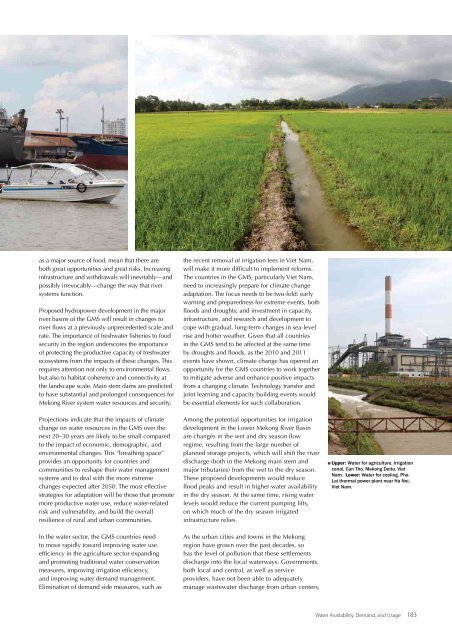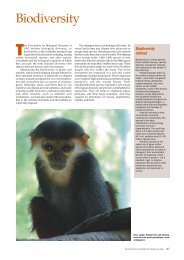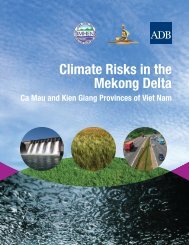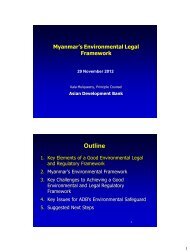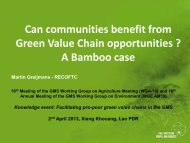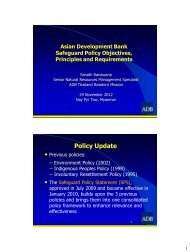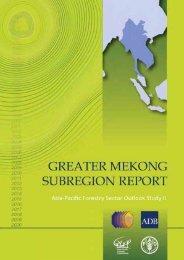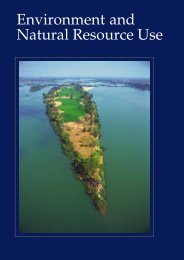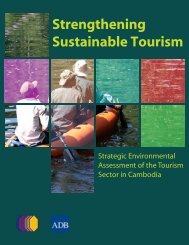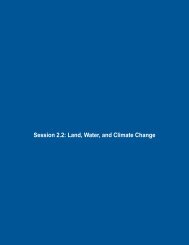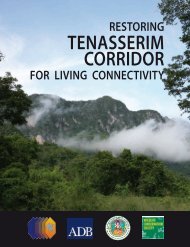Upper left: Water for health. Familybath<strong>in</strong>g <strong>in</strong> a river, Champasak, LaoPDR. Lower left: Prist<strong>in</strong>e stream, LaoPDR. Above right: Water for transport.The Saigon River at Ho Chi M<strong>in</strong>h City,Viet Nam, an important waterway forvessels large and small.(BOD); pollutants <strong>in</strong> wastewater from fishprocess<strong>in</strong>g generate BOD, nitrogen, andsuspended solids. Water pollution from <strong>in</strong>dustrialsources has been identified, especially <strong>in</strong> <strong>the</strong>capital cities of Vientiane and Phnom Penh, andmore generally <strong>in</strong> nor<strong>the</strong>astern Thailand and <strong>the</strong>Mekong Delta. Generally, treatment of <strong>in</strong>dustrialwastewater is limited and handl<strong>in</strong>g and disposalof <strong>in</strong>dustrial hazardous waste are <strong>in</strong>sufficient.So far, <strong>in</strong>dustrial water pollution is ma<strong>in</strong>lyconcentrated around factories and downstreamof major urban areas. With <strong>in</strong>creas<strong>in</strong>g<strong>in</strong>dustrialization, more severe water dischargeproblems will occur and <strong>in</strong>ter-sectoral conflictsover water quality demands may <strong>in</strong>crease.Industrial waste water management <strong>in</strong> Cambodiais poor, few factories have waste water treatmentfacilities, and control of <strong>in</strong>dustrial waste waterdischarge is not enforced. Of <strong>the</strong> factories <strong>in</strong>Phnom Penh, only eight have on-site primarytreatment and <strong>the</strong>ir effluents generally exceedCambodia’s water quality standards. Ano<strong>the</strong>rpollution problem relates to gemstone m<strong>in</strong><strong>in</strong>gactivities <strong>in</strong> <strong>the</strong> western part of <strong>the</strong> country.Industrial activity <strong>in</strong> <strong>the</strong> Thai part of <strong>the</strong>Lower Mekong River Bas<strong>in</strong> is dom<strong>in</strong>ated bymanufactur<strong>in</strong>g (<strong>in</strong>clud<strong>in</strong>g agro-<strong>in</strong>dustry, but alsosome textile production, light assembly, andrubber process<strong>in</strong>g). Industrial wastes are expectedto <strong>in</strong>crease as <strong>the</strong> sector expands. Over <strong>the</strong> next10 years, pollution load<strong>in</strong>g is expected to <strong>in</strong>creaseby 87%. Industrial development is also <strong>in</strong>creas<strong>in</strong>g<strong>the</strong> amounts of hazardous wastes. In nor<strong>the</strong>asternThailand, <strong>the</strong> generation of hazardous wastesis expected to <strong>in</strong>crease by about 72% over <strong>the</strong>next five years. All factories are required to have<strong>the</strong>ir own wastewater recycl<strong>in</strong>g system to allowcontam<strong>in</strong>ants to settle before water is released.In Viet Nam, water pollution is serious, especially <strong>in</strong>rivers and canals near urban centers. Most <strong>in</strong>dustrialwastewater is discharged without proper treatment.Hazardous wastes are generated by <strong>the</strong> fastestgrow<strong>in</strong>g sectors, such as steel, electronics, andchemicals. Overall, <strong>the</strong>re are no systems <strong>in</strong> placefor <strong>the</strong> handl<strong>in</strong>g, storage, or treatment of hazardouswastes. In <strong>the</strong> Mekong Delta, where developmentof <strong>in</strong>dustry has been relatively slow, exist<strong>in</strong>g<strong>in</strong>dustries have caused quite serious water pollution(e.g., organic contam<strong>in</strong>ation from breweries andcanneries). Heavy <strong>in</strong>dustry is becom<strong>in</strong>g significantwith <strong>the</strong> <strong>in</strong>itiation of a steel roll<strong>in</strong>g mill <strong>in</strong> Can Thowith a capacity of 120,000 tons per year.Transboundary Water Pollution. There is nostrong evidence of transboundary pollutionwith<strong>in</strong> <strong>the</strong> Lower Mekong River Bas<strong>in</strong>, althoughelevated nitrogen levels <strong>in</strong> <strong>the</strong> upper bas<strong>in</strong><strong>in</strong>dicate some transboundary transmission ofpollutants from <strong>the</strong> upper to <strong>the</strong> lower bas<strong>in</strong>. Therapid development and <strong>in</strong>creas<strong>in</strong>g pollution of<strong>the</strong> upper Mekong bas<strong>in</strong> <strong>in</strong> <strong>the</strong> PRC raises someconcerns about <strong>the</strong> future quality of <strong>in</strong>com<strong>in</strong>gwater from <strong>the</strong> upper bas<strong>in</strong>. The Mekong Rivertransports large amounts of sediment, muchof which orig<strong>in</strong>ates <strong>in</strong> <strong>the</strong> upper bas<strong>in</strong>. Thisprocess helps to redistribute nutrients with<strong>in</strong><strong>the</strong> bas<strong>in</strong> and is very important for areas of highproductivity, such as Tonle Sap. In this sense,transboundary transportation of nutrients along<strong>the</strong> river has so far been regarded as a benefitra<strong>the</strong>r than a cause of pollution.Water Security Challenges. Over <strong>the</strong> next decade,<strong>the</strong> countries of <strong>the</strong> <strong>GMS</strong> face decisions about waterresource development that will have far-reach<strong>in</strong>gconsequences. The relatively low level of waterresource development <strong>in</strong> <strong>the</strong> region to date and highlevels of dependence on natural aquatic ecosystems182 Water Availability, Demand, and Usage
as a major source of food, mean that <strong>the</strong>re areboth great opportunities and great risks. Increas<strong>in</strong>g<strong>in</strong>frastructure and withdrawals will <strong>in</strong>evitably—andpossibly irrevocably—change <strong>the</strong> way that riversystems function.Proposed hydropower development <strong>in</strong> <strong>the</strong> majorriver bas<strong>in</strong>s of <strong>the</strong> <strong>GMS</strong> will result <strong>in</strong> changes toriver flows at a previously unprecedented scale andrate. The importance of freshwater fisheries to foodsecurity <strong>in</strong> <strong>the</strong> region underscores <strong>the</strong> importanceof protect<strong>in</strong>g <strong>the</strong> productive capacity of freshwaterecosystems from <strong>the</strong> impacts of <strong>the</strong>se changes. Thisrequires attention not only to environmental flows,but also to habitat coherence and connectivity at<strong>the</strong> landscape scale. Ma<strong>in</strong> stem dams are predictedto have substantial and prolonged consequences forMekong River system water resources and security.Projections <strong>in</strong>dicate that <strong>the</strong> impacts of climatechange on water resources <strong>in</strong> <strong>the</strong> <strong>GMS</strong> over <strong>the</strong>next 20–30 years are likely to be small comparedto <strong>the</strong> impact of economic, demographic, andenvironmental changes. This “breath<strong>in</strong>g space”provides an opportunity for countries andcommunities to reshape <strong>the</strong>ir water managementsystems and to deal with <strong>the</strong> more extremechanges expected after 2050. The most effectivestrategies for adaptation will be those that promotemore productive water use, reduce water-relatedrisk and vulnerability, and build <strong>the</strong> overallresilience of rural and urban communities.In <strong>the</strong> water sector, <strong>the</strong> <strong>GMS</strong> countries needto move rapidly toward improv<strong>in</strong>g water useefficiency <strong>in</strong> <strong>the</strong> agriculture sector expand<strong>in</strong>gand promot<strong>in</strong>g traditional water conservationmeasures, improv<strong>in</strong>g irrigation efficiency,and improv<strong>in</strong>g water demand management.Elim<strong>in</strong>ation of demand side measures, such as<strong>the</strong> recent removal of irrigation fees <strong>in</strong> Viet Nam,will make it more difficult to implement reforms.The countries <strong>in</strong> <strong>the</strong> <strong>GMS</strong>, particularly Viet Nam,need to <strong>in</strong>creas<strong>in</strong>gly prepare for climate changeadaptation. The focus needs to be two-fold: earlywarn<strong>in</strong>g and preparedness for extreme events, bothfloods and droughts; and <strong>in</strong>vestment <strong>in</strong> capacity,<strong>in</strong>frastructure, and research and development tocope with gradual, long-term changes <strong>in</strong> sea-levelrise and hotter wea<strong>the</strong>r. Given that all countries<strong>in</strong> <strong>the</strong> <strong>GMS</strong> tend to be affected at <strong>the</strong> same timeby droughts and floods, as <strong>the</strong> 2010 and 2011events have shown, climate change has opened anopportunity for <strong>the</strong> <strong>GMS</strong> countries to work toge<strong>the</strong>rto mitigate adverse and enhance positive impactsfrom a chang<strong>in</strong>g climate. Technology transfer andjo<strong>in</strong>t learn<strong>in</strong>g and capacity build<strong>in</strong>g events wouldbe essential elements for such collaboration.Among <strong>the</strong> potential opportunities for irrigationdevelopment <strong>in</strong> <strong>the</strong> Lower Mekong River Bas<strong>in</strong>are changes <strong>in</strong> <strong>the</strong> wet and dry season flowregime, result<strong>in</strong>g from <strong>the</strong> large number ofplanned storage projects, which will shift <strong>the</strong> riverdischarge (both <strong>in</strong> <strong>the</strong> Mekong ma<strong>in</strong> stem andmajor tributaries) from <strong>the</strong> wet to <strong>the</strong> dry season.These proposed developments would reduceflood peaks and result <strong>in</strong> higher water availability<strong>in</strong> <strong>the</strong> dry season. At <strong>the</strong> same time, ris<strong>in</strong>g waterlevels would reduce <strong>the</strong> current pump<strong>in</strong>g lifts,on which much of <strong>the</strong> dry season irrigated<strong>in</strong>frastructure relies.As <strong>the</strong> urban cities and towns <strong>in</strong> <strong>the</strong> Mekongregion have grown over <strong>the</strong> past decades, sohas <strong>the</strong> level of pollution that <strong>the</strong>se settlementsdischarge <strong>in</strong>to <strong>the</strong> local waterways. Governments,both local and central, as well as serviceproviders, have not been able to adequatelymanage wastewater discharge from urban centers,Upper: Water for agriculture. Irrigationcanal, Can Tho, Mekong Delta, VietNam. Lower: Water for cool<strong>in</strong>g. PhaLai <strong>the</strong>rmal power plant near Ha Noi,Viet Nam.Water Availability, Demand, and Usage 183
- Page 3 and 4: Importance of Rice. The GMS is home
- Page 5 and 6: The Causes and Extent of LandDegrad
- Page 7 and 8: Agroecological ZonesThe GMS compris
- Page 9 and 10: whom 46 million live in Yunnan Prov
- Page 11: Agriculture, Fisheries, and Food Se
- Page 18 and 19: Upper: Fish from the Mekong River f
- Page 20: 172 Greater Mekong Subregion Atlas
- Page 24 and 25: Above:Province, central Viet Nam. R
- Page 26: e severe. With rapidly declining pu
- Page 29: Annual Irrigation Demand, LowerMeko
- Page 33 and 34: EnergyOver the last two decades, ra
- Page 35 and 36: equirements that marked the previou
- Page 37 and 38: Energy Resource Base in the GMSCoun
- Page 39 and 40: generation biofuels, have begun to
- Page 41 and 42: energy. Use of renewable energy exp
- Page 44 and 45: 196 Greater Mekong Subregion Atlas
- Page 46 and 47: Upper and Lower: Construction of th
- Page 48 and 49: 200 Greater Mekong Subregion Atlas
- Page 50 and 51: 1990Nay Pyi Taw, Myanmar(Left)and 2
- Page 52 and 53: Upper: Bangkok’s mass transitsyst
- Page 54 and 55: Satellite images of Kunming City, c
- Page 56 and 57: Number of Vehicles per 1,000Persons
- Page 58 and 59: 210 Greater Mekong Subregion Atlas
- Page 60 and 61: GMS Passenger Transport (million pa
- Page 62 and 63: Rush hour traffic in Ho Chi Minh Ci
- Page 64 and 65: Traffic congestion in Bangkok,Thail
- Page 66 and 67: Rehabilitated passenger train,Cambo
- Page 68 and 69: kilometers in 2008. Most lines run
- Page 70 and 71: Upper left: Yangon River port,Myamn
- Page 72 and 73: 224 Greater Mekong Subregion Atlas
- Page 74: Suvarnabhumi airport terminal,Bangk
- Page 77 and 78: GMS International Tourist Arrivals
- Page 80 and 81:
232 Greater Mekong Subregion Atlas
- Page 82 and 83:
Satellite images showing developmen
- Page 84:
While GMS tourism growth is predomi


